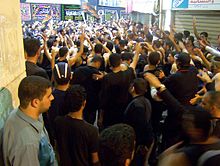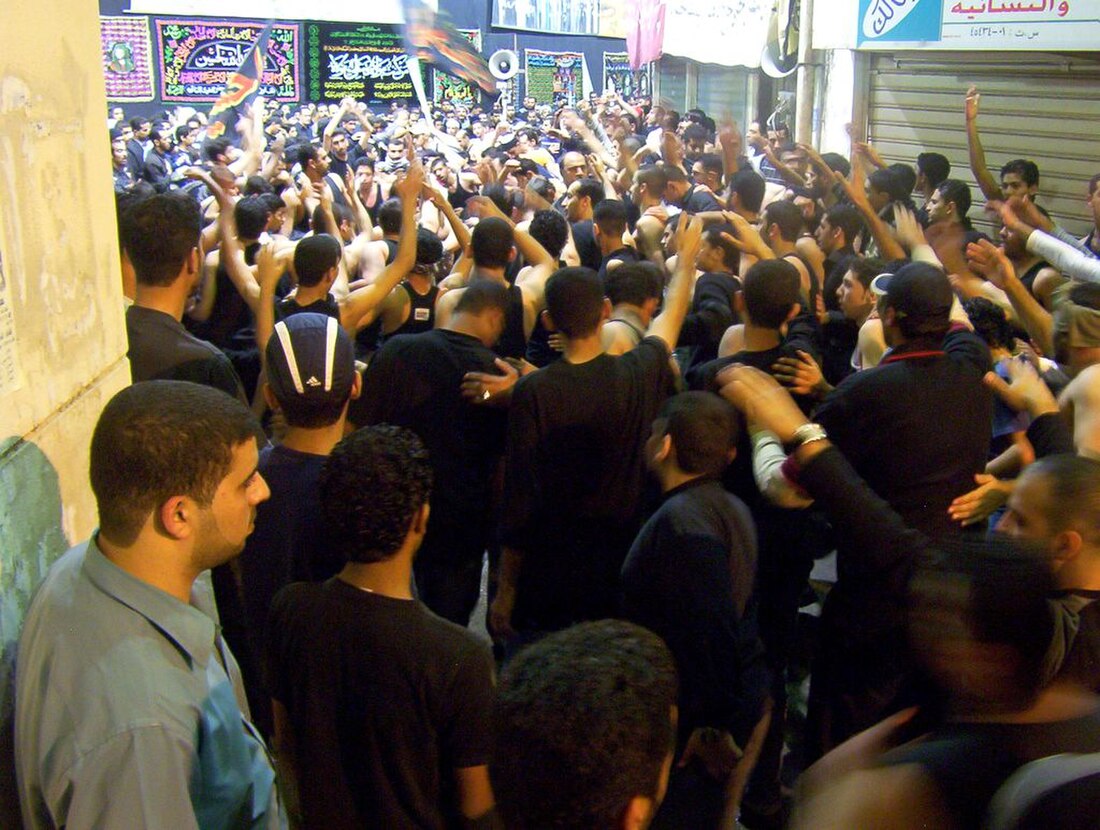The Bahārna (Arabic: بُحارنة) are an ethnoreligious group of Shia Muslim Arabs indigenous to the historical region of Bahrain. They are generally regarded to be the original inhabitants of Eastern Arabia.[1] They inhabited the area even before the arrival of the Banu Utbah in the 18th century which the Bahraini royal family descends from.[2] Most Bahraini citizens are Baharna. Regions with most of the population are in Eastern Arabia (Bahrain, Qatif, al-Ahsa), with significant populations in Kuwait, United Arab Emirates, Qatar, Oman, Iraq, Khoramshahr, Hormozgan province of Iran.[3][4][5]
 Bahārna during Muharram | |
| Regions with significant populations | |
|---|---|
| Bahrain, Kuwait, Qatif, Al-Hasa, Iran (Hormozgan province) | |
| Languages | |
| Arabic (Bahrani Arabic, Gulf Arabic) | |
| Religion | |
| Shia Islam |
Origin
The origin of the Baharna is debated;[1] there are different theories regarding their origins. Several Western scholars believe the Baharna originate from Bahrain's ancient population and pre-Islamic population which consisted of partially-Christianized Arabs,[6][7] Aramaic-speaking agriculturalists,[6][8][9] Persian Zoroastrians, and a small amount of Jews.[1] According to one historian, Arab settlements in Bahrain may have begun around 300 B.C. and control of the island was maintained by the Rabyah tribe, who converted to Islam in 630 A.D.[10]
Local anecdotal evidence suggests that the Baharna's ancestry is diverse as some word variants spoken in the dialects of the native people of the villages of Bani Jamra and A'ali are only used in places as far as Yemen and Oman, indicating southern Arabian ancestry.[11] Many Baharna families descended from members of the Banu Abdul Qays, who were mostly Nestorian Christians before the seventh century,[12] as-well as the Anizah tribe which is a cousin tribe the Abd Al-Qays and are both part of the greater Rab’ia tribe. Many are also from the Bani Tamim tribe, such as the ruler of Bahrain during the early islamic era, and Al-Azd.[13]
The Bahrani Arabic dialect exhibits Akkadian, Aramaic and Syriac features.[14][15] The sedentary people of pre-Islamic Bahrain were Aramaic speakers and to some degree Persian speakers, while Syriac functioned as a liturgical language.[8] The Bahrani dialect might have borrowed the Akkadian, Aramaic and Syriac features from Mesopotamian Arabic.[16]
According to Robert Bertram Serjeant, the Baharna may be the last of the "descendants of converts from the original population of Christians (Aramaeans), Jews and ancient Persians/Iranians (Majus) inhabiting the island and cultivated coastal provinces of Eastern Arabia at the time of the Arab conquest".[6][17]
Genetics
Bahrani people are mostly (around 37~50%) eastern peninsular Arabs and (around 30%~) North West Asian (Iranian, Caucasian, and Mespotamian) according to their genes.[citation needed] Further DNA testing is required.
Etymology
The term Bahrani serves to distinguish the Bahrana from other Bahraini ethnic groups, such as the ethnic Persian Bahrainis who fall under the term Ajam, as well as from the Sunni Arabs in Bahrain who are known as Al Arab ("Arabs"), such as Bani Utbah.[18] In the United Arab Emirates, the Baharna make up 5% of Emiratis and are generally descended from Baharna coming around 100–200 years ago.[19]
In Arabic, bahrayn is the dual form of bahr ("sea"), so al-Bahrayn means "the Two Seas". However, which two seas were originally intended remains in dispute.[20] The term appears five times in the Qur'an, but does not refer to the modern island—originally known to the Arabs as "Awal".
Today, Bahrain's "two seas" are instead generally taken to be the bay east and west of the island,[21] the seas north and south of the island,[citation needed] or the salt and fresh water present above and below the ground.[22] In addition to wells, there are places in the sea north of Bahrain where fresh water bubbles up in the middle of the salt water, noted by visitors since antiquity.[23]
An alternate theory offered by al-Ahsa was that the two seas were the Persian Gulf and a peaceful lake on the mainland Near Al-Ahsa, known as Al-Asfar Lake; still another provided by Ismail ibn Hammad al-Jawhari is that the more formal name Bahri (lit. "belonging to the sea") would have been misunderstood and so was opted against.[22]
History
Between 1501-1800 the Safavid Empire, which controlled parts of the Gulf region, including Bahrain, was a Shia-majority empire.[citation needed] The Baharna, being predominantly Shia, generally aligned with the Safavids.[citation needed] However, the region experienced ongoing political and sectarian tensions between the Safavids and their rivals, such as the Ottomans and various Sunni Arab tribes.[citation needed] During the later part of Safavid rule, some Baharna families left Bahrain and sought refuge in Khuzestan, particularly when political instability and conflicts with neighbouring Sunni tribes increased. This phase of migration happened in the 17th century.
After the Safavid Empire fell in the early 18th century, Bahrain became vulnerable to invasions and shifts in power. The Omani invasion of Bahrain in 1717 destabilized the region, causing internal strife and pressure on the Shia Baharna population.[citation needed] The uncertainty and insecurity in Bahrain led some Baharna to migrate to Khuzestan, where they found refuge among local Arab tribes, such as the Muhammarah. This migration was more sporadic but occurred during the early 18th century.[citation needed]
In 1783, the Al Khalifa family, who were Sunni Arabs from the Najd region (modern-day Saudi Arabia), took control of Bahrain after defeating the Persian rulers who were aligned with the Baharna.[citation needed] This shift in power led to increased sectarian tensions, as the predominantly Sunni Al Khalifa rulers imposed their authority over the Shia Baharna population. Many Baharna felt marginalized and oppressed under the new rule. Consequently, a significant number of Baharna families migrated to Khuzestan during the late 18th century, where they settled and integrated with Arab tribes like Banu Kaab and Banu Kanaan.[citation needed]
Throughout the 19th century, Bahrain continued to experience internal conflicts, especially between the ruling Al Khalifa family and the Baharna population. Disputes over land, taxation, and sectarian discrimination pushed more Baharna to seek better conditions elsewhere.[citation needed] During this period, additional Baharna families migrated to Khuzestan, where they joined the earlier waves of migrants. By this time, they had established strong ties with local Arab tribes, including the House of Ghannam and the Al Hilalat.[citation needed]
The journey of return for some Baharnah to their homeland of Bahrain began in 1951, following the intensification of Persian harassment campaigns against the Arabs of Muhammarah. Some of them were politically active within the ranks of the Arab national movement, which aimed to restore Arab rule.[5]
Notable people

- Abdul Hadi Al-Khawaja, Bahraini political activist.
- Ramin Bahrani
- Ayat Al-Qarmizi
- Nabil Rajab
- Mahdi Abu Deeb
- Hassan Mushaima
- Zainab Al-Khawaja, Bahraini political activist and daughter of Abdul Hadi Al-Khawaja.
- Mohammed Haddad
- Mohammed Sayed Adnan
- Mohammed Al-Maskati
- Hussain Al-Sabaa
- Tariq Al-Farsani
- Jassim Al-Huwaidi
- Alaa Hubail, Bahraini footballer.
See also
Language and culture
Geography
Bahrani People
References
External links
Wikiwand in your browser!
Seamless Wikipedia browsing. On steroids.
Every time you click a link to Wikipedia, Wiktionary or Wikiquote in your browser's search results, it will show the modern Wikiwand interface.
Wikiwand extension is a five stars, simple, with minimum permission required to keep your browsing private, safe and transparent.
